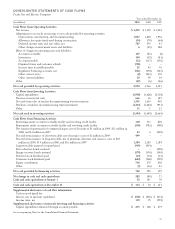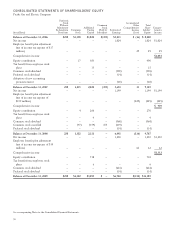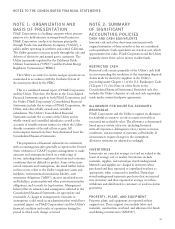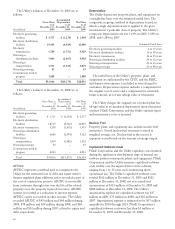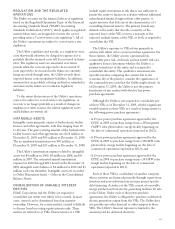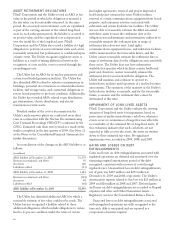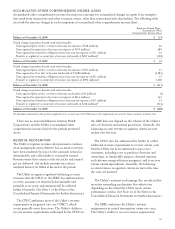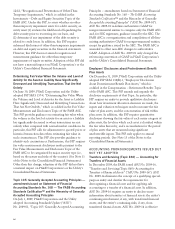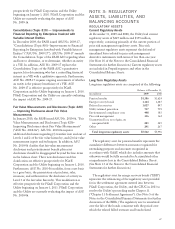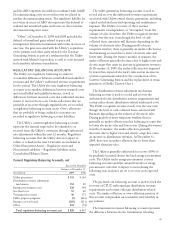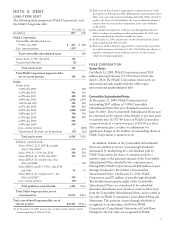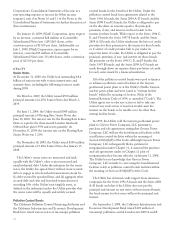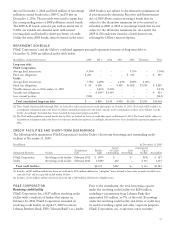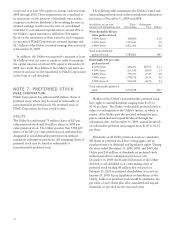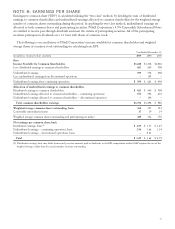PG&E 2009 Annual Report Download - page 71
Download and view the complete annual report
Please find page 71 of the 2009 PG&E annual report below. You can navigate through the pages in the report by either clicking on the pages listed below, or by using the keyword search tool below to find specific information within the annual report.
prospectively for PG&E Corporation and the Utility
beginning on January 1, 2010. PG&E Corporation and the
Utility are currently evaluating the impact of ASU
No. 2009-16.
Consolidations (Topic 810) — Improvements to
Financial Reporting by Enterprises Involved with
Variable Interest Entities
In December 2009, the FASB issued ASU No. 2009-17,
“Consolidations (Topic 810)—Improvements to Financial
Reporting by Enterprises Involved with Variable Interest
Entities” (“ASU No. 2009-17”). ASU No. 2009-17 amends
the Consolidation Topic of the FASB ASC regarding when
and how to determine, or re-determine, whether an entity
is a VIE. In addition, ASU No. 2009-17 replaces the
Consolidation Topic of the FASB ASC’s quantitative
approach for determining who has a controlling financial
interest in a VIE with a qualitative approach. Furthermore,
ASU No. 2009-17 requires ongoing assessments of whether
an entity is the primary beneficiary of a VIE. ASU
No. 2009-17 is effective prospectively for PG&E
Corporation and the Utility beginning on January 1, 2010.
PG&E Corporation and the Utility are currently evaluating
the impact of ASU No. 2009-17.
Fair Value Measurements and Disclosures (Topic 820)
— Improving Disclosures about Fair Value
Measurements
In January 2010, the FASB issued ASU No. 2010-06, “Fair
Value Measurements and Disclosures (Topic 820)—
Improving Disclosures about Fair Value Measurements”
(“ASU No. 2010-06”). ASU No. 2010-06 requires
additional disclosures regarding (1) transfers into and out of
Levels 1 and 2 of the fair value hierarchy, and (2) fair value
measurement inputs and techniques. In addition, ASU
No. 2010-06 clarifies that fair value measurement
disclosures and postretirement benefit plan asset
disclosures should be disaggregated beyond the line items
in the balance sheet. These new disclosures and this
clarification are effective prospectively for PG&E
Corporation and the Utility beginning on January 1, 2010.
Furthermore, ASU No. 2010-06 modifies, from a net basis
to a gross basis, the presentation of purchases, sales,
issuances, and settlements in the disclosure of activity in
Level 3 of the fair value hierarchy. This modification is
effective prospectively for PG&E Corporation and the
Utility beginning on January 1, 2011. PG&E Corporation
and the Utility are currently evaluating the impact of ASU
No. 2010-06.
NOTE 3: REGULATORY
ASSETS, LIABILITIES, AND
BALANCING ACCOUNTS
REGULATORY ASSETS
Current Regulatory Assets
At December 31, 2009 and 2008, the Utility had current
regulatory assets of $427 million and $355 million,
respectively, consisting primarily of the current portion of
price risk management regulatory assets. Price risk
management regulatory assets represent the deferral of
unrealized losses related to price risk management
derivative instruments with terms of less than one year.
(See Note 10 of the Notes to the Consolidated Financial
Statements for further discussion.) Current regulatory assets
are included in Prepaid expenses and other in the
Consolidated Balance Sheets.
Long-Term Regulatory Assets
Long-term regulatory assets are composed of the following:
Balance at December 31,
(in millions) 2009 2008
Pension benefits $1,386 $1,624
Energy recovery bonds 1,124 1,487
Deferred income tax 1,027 847
Utility retained generation 737 799
Environmental compliance costs 408 385
Price risk management 346 362
Unamortized loss, net of gain, on
reacquired debt 203 225
Other 291 267
Total long-term regulatory assets $5,522 $5,996
The regulatory asset for pension benefits represents the
cumulative differences between amounts recognized for
ratemaking purposes and amounts recognized in
accordance with GAAP, which also includes amounts that
otherwise would be fully recorded to Accumulated other
comprehensive loss in the Consolidated Balance Sheets.
(See Note 13 of the Notes to the Consolidated Financial
Statements for further discussion.)
The regulatory asset for energy recovery bonds (“ERB”)
represents the refinancing of the regulatory asset provided
for in the settlement agreement entered into between
PG&E Corporation, the Utility, and the CPUC in 2003 to
resolve the Utility’s proceeding under Chapter 11
(“Chapter 11 Settlement Agreement”). (See Note 5 of the
Notes to the Consolidated Financial Statements for further
discussion of the ERBs.) The regulatory asset is amortized
over the life of the bonds consistent with the period over
which the related billed revenues and bond-related
67


